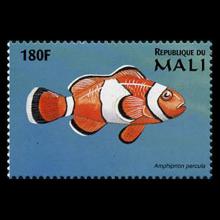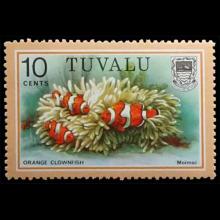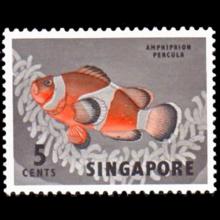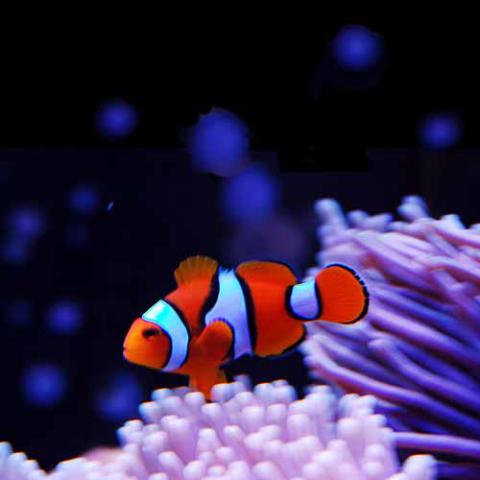NAMES
TAXONOMY
Mali
Issued:
Stamp:
Amphiprion percula
Tuvalu
Issued:
Stamp:
Amphiprion percula
Singapore
Issued:
Stamp:
Amphiprion percula
Mali
Issued:
Stamp:
Amphiprion percula
Tuvalu
Issued:
Stamp:
Amphiprion percula
Singapore
Issued:
Stamp:
Amphiprion percula
Mali
Issued:
Stamp:
Amphiprion percula
Tuvalu
Issued:
Stamp:
Amphiprion percula
Singapore
Issued:
Stamp:
Amphiprion percula
Nemo's nose helps find way home
Wednesday, 27 August 2008, Darren Osborne, ABC Science
The animated clownfish Nemo may have found his way home a lot sooner if he had trusted his nose, according to researchers. The research by scientists from Australia, France and the US, has revealed that a species of clownfish (Amphiprion percula) uses its olfactory senses to help it locate a suitable habitat. The findings appear in the latest edition of the Proceedings of the Royal Society B. Professor Geoff Jones of James Cook University, Townsville, says that although previous research has shown clownfish can smell, these new findings identify the scents they are using
"It's always been a mystery to us how they find their way back to a suitable habitat," says Jones. "We've actually narrowed down the chemical signals that they may be using to find their home."
Attractive scent
To determine which scents the fish use, researchers collected newly settled juveniles from reefs located in the Kimbe Bay region of New Britain - an island off the east coast of Papua New Guinea. They placed each fish in a specially designed Y-shaped tank that contained two flowing sources of water. The fish were then observed to see which source they swam towards. Almost all exhibited a strong preference for water collected from reefs that contained islands. The researchers then used water that contained the scent of an anemone or leaves from coastal plants such as Xanthostemon. When given a choice between scented or unscented water the fish spent more than 90% of their time in the scented water.
"We were quite surprised to find that one of the things they were using was a terrestrial cue - leaves falling into the water," says Jones.
He believes the juvenile clownfish are pre-programmed to head towards the source of the leaf smell to help them find a home. But the fish didn't head to water scented by all leaves. Water scented with Melaleuca nervosa, a swamp tree that has leaves containing a pungent oil, were rejected by all fish.
Management implications
The researchers say the results of the study "have important implications for the management of island reef ecosystems."
"If we're managing coral reefs, we need to integrate that management with the surrounding forests," says Jones.
"If you chop down all the rainforest and planted Melaleuca, my feeling is that they wouldn't be able to find those islands anymore." He adds that tourism could also impact upon the clownfish's ability to smell its way home.
"Reefs with islands on them should be targeted by reef management because they become (places) that people use, and there's usually a limited land area on islands, which quite often is modified," says Jones. [He] says the team is continuing its research into clownfish to identify how far they are swept out to sea when they are larvae, and whether they also use other cues to help them find a home.
"Are they maintaining themselves nearby and smelling their way back home, or are they getting taken much further away and using a whole variety of means to find their way back?" he says. "There are still a lot of unanswered questions."
Genus species (Animalia): Amphiprion percula
The orange clownfish (Amphiprion percula) also known as percula clownfish and clown anemonefish, is widely known as a popular aquarium fish. Like other clownfishes (also known as anemonefishes), it often lives in association with sea anemones. A. percula is associated specifically with Heteractis magnifica and Stichodactyla gigantea, and as larvae use chemical cues released from the anemones to identify and locate the appropriate host species to use them for shelter and protection. This causes preferential selection when finding their anemone host species. Although popular, maintaining this species in captivity is rather complex. The Great Barrier Reef Marine Park Authority regulates the number of collection permits issued to aquarium fish dealers who seek this, and other tropical fish within the Great Barrier Reef Marine Park. The symbiosis between anemonefish and anemones depends on the presence of the fish drawing other fish to the anemone, where they are stung by its venomous tentacles. The anemone helps the fish by giving it protection from predators, which include brittle stars, wrasses, and other damselfish, and the fish helps the anemone by feeding it, increasing oxygenation, and removing waste material from the host. Various hypotheses exist about the fish's ability to live within the anemone without being harmed. One study carried out at Marineland of the Pacific by Dr. Demorest Davenport and Dr. Kenneth Noris in 1958 revealed that the mucus secreted by the anemone fish prevented the anemone from discharging its lethal stinging nematocysts. A second hypothesis is that A. percula has acquired immunity towards the sea anemone's toxins, and a combination of the two has been shown to be the case. The fish feed on algae, zooplankton, worms, and small crustaceans.
Reference: Wikipedia




